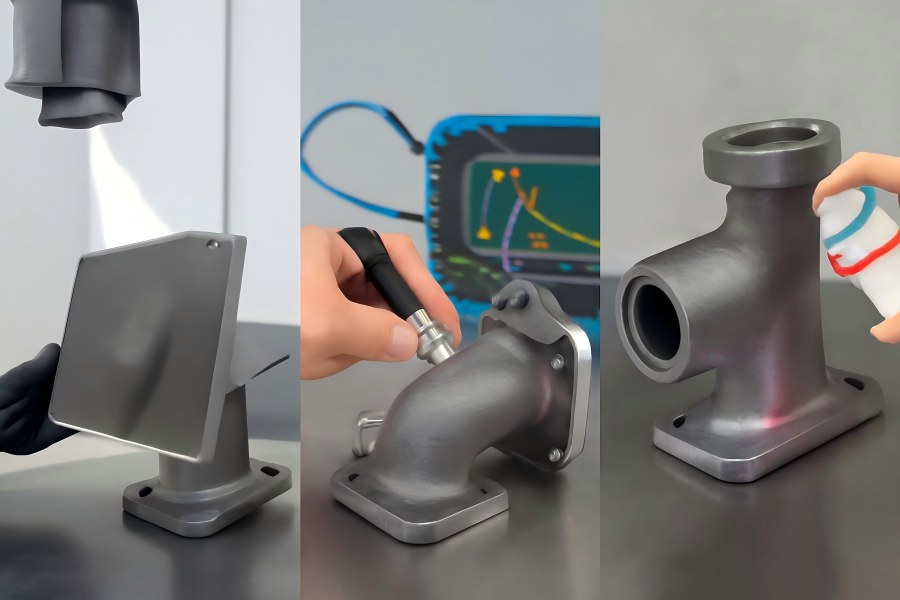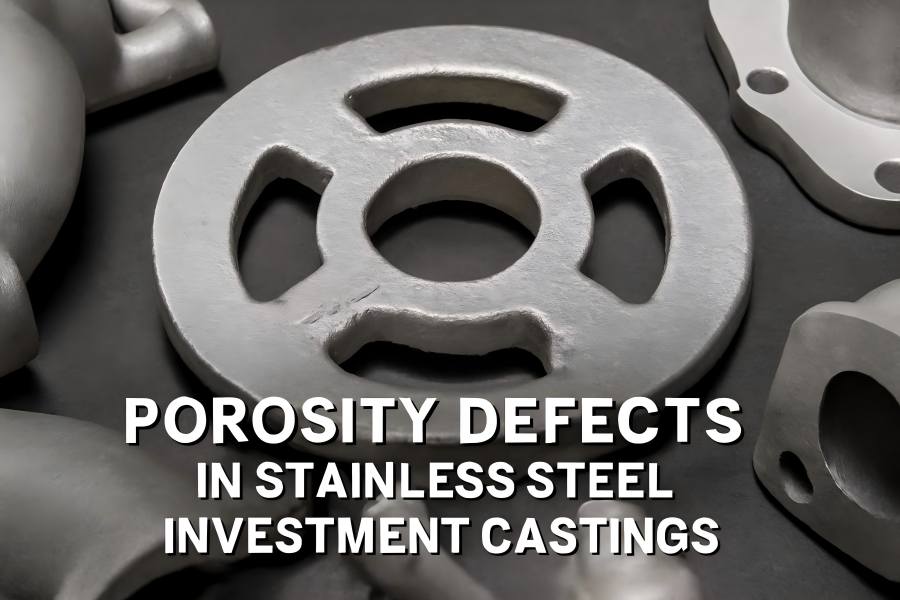For manufacturing high-precision parts required in sectors including aerospace, automotive, and medical equipment, stainless steel investment casting is a crucial technique. The process involves pouring molten stainless steel into molds to create intricate parts. However, managing porosity defects is a significant challenge, as it can compromise the mechanical properties, appearance, and overall quality of the final product.
This article examines the causes, impacts, and solutions for controlling porosity in stainless steel investment castings to improve product quality and manufacturing efficiency.
Understanding Porosity in Stainless Steel Castings
Porosity in stainless steel castings refers to the presence of small cavities or holes within the casting structure. These voids can occur due to gas entrapment, solidification shrinkage, or contamination during the casting process. Porosity defects can be classified into three primary types:
- Microporosity: Tiny voids that are generally distributed throughout the casting and can be difficult to detect without high-resolution inspection methods.
- Macroporosity: Larger voids or holes, which can lead to weak spots in the casting structure and are more easily detected.
- Surface Porosity: Small holes or indentations found on the casting surface, often caused by surface tension or improper cooling conditions.
Porosity significantly impacts the structural integrity of castings, affecting their mechanical properties, such as strength and fatigue resistance, making it a critical issue to address in stainless steel investment casting.
Common Causes of Porosity in Stainless Steel Investment Castings
Porosity defects arise from various causes throughout the casting process. In order to adopt effective solutions to prevent the incidence of these flaws, it is imperative to comprehend these reasons.
Gas Entrapment
Porosity is created when gasses from the molten metal are trapped in the casting, a phenomenon known as gas entrapment. This can happen when there is insufficient venting in the mold or when gases are dissolved in the molten metal but cannot escape quickly enough. Common causes of gas entrapment include:
- Dissolved gases: Oxygen, hydrogen, or nitrogen can dissolve into molten metal, and if the casting process does not allow these gases to escape, they form bubbles that become trapped as porosity in the casting.
- Inadequate venting: Insufficient venting in the mold can prevent gases from escaping, leading to the entrapment of gas pockets in the final casting.
Shrinkage Porosity
Shrinkage porosity occurs during the cooling and solidification phase when the molten metal shrinks as it solidifies. This shrinkage can create voids in the casting if there is not enough liquid metal to compensate for the volume loss. Factors contributing to shrinkage porosity include:
- Improper gating system design: An inadequate gating system may fail to deliver sufficient molten metal to the casting, leading to voids and shrinkage defects.
- Insufficient feed metal: Lack of feed metal to compensate for shrinkage during cooling can result in void formation, especially in thicker sections of the casting.
Inadequate Shell Strength
The shell used in investment casting plays a vital role in supporting the molten metal during pouring and solidification. If the shell is too thin or not strong enough, it may crack or break during the casting process, leading to the formation of porosity. Common causes of inadequate shell strength include:
- Weak shell material: If the investment material is not properly mixed or lacks strength, it may not withstand the heat and pressure of the molten metal, resulting in cracks that allow gas and molten metal to escape.
- Inconsistent shell thickness: Uneven shell thickness can lead to regions of weak spots, causing porosity to form.
Contamination of Mold Material
Contamination of the mold material can introduce foreign particles or moisture into the casting, leading to the formation of porosity. Common contaminants include:
- Moisture in the mold: When molds are not properly dried before pouring, moisture trapped in the mold can vaporize when exposed to the molten metal, causing gas to be trapped and resulting in porosity.
- Foreign particles: Particles of sand, dust, or other materials can enter the mold during preparation and contaminate the casting, leading to surface or internal porosity.
Improper Wax Pattern Handling
In investment casting, the quality of the wax patterns is crucial. If the wax patterns are not properly handled, they can introduce defects that result in porosity. Some common issues include:
- Poor wax quality: Low-quality wax may lead to incomplete patterns, affecting the casting’s integrity and leading to porosity in the final product.
- Dewaxing process issues: Inadequate dewaxing can leave traces of wax inside the mold, which, when exposed to the molten metal, can create voids.
Effects of Porosity on Casting Performance
Porosity defects in stainless steel castings can severely affect their mechanical properties and overall performance. Some of the key impacts include:
- Mechanical Properties: Porosity weakens the material structure, leading to reduced tensile strength, fatigue resistance, and overall durability. Significant porosity increases the likelihood of cracking and failure in castings under load.
- Aesthetic Quality: Surface porosity can lead to poor surface finish, affecting the visual appeal of the final product, especially in industries like aerospace and medical device manufacturing where aesthetics are critical.
- Economic Impact: Porosity defects result in high scrap rates, rework, and rejection of castings, leading to increased production costs. Additionally, repairs and post-processing treatments to eliminate or reduce porosity further add to costs.
Solutions to Prevent and Control Porosity
Addressing porosity defects requires a combination of better process control, material selection, and design optimization. Below are several solutions to prevent and control porosity in stainless steel investment castings.
Improved Gating and Venting Systems
An optimized gating system ensures that molten metal flows smoothly into the mold and is adequately supplied to all areas of the casting. It is important to carefully plan ventilation systems so that gases can escape during pouring and solidification. Important actions consist of:
- Optimizing gating design: To prevent air pockets and turbulence, gating systems should be made to let the molten metal flow smoothly into every part of the mold.
- Strategic vent placement: Venting systems should be placed at the highest points of the mold to ensure that gases can escape as the metal solidifies.
Material Selection and Control
Choosing the right alloy and controlling the gas content in the molten metal are crucial to reducing gas-related porosity. Solutions include:
- Alloy selection: Using low-gas-alloyed stainless steel grades can reduce the risk of gas entrapment.
- Gas control: Ensuring that the molten metal is properly degassed before pouring can prevent gas from becoming trapped during solidification.
Enhanced Shell Design and Thickness
Strengthening the mold shell can help prevent cracks and defects during the casting process. Solutions include:
- Increasing shell thickness: Thicker molds are less likely to crack under the pressure of molten metal, reducing the risk of porosity.
- Reinforcing shell structure: Reinforcing the mold shell with advanced materials like zirconia or using multi-layer coatings can improve its strength.
Improved Wax Pattern Handling
To reduce defects related to wax patterns, it’s essential to ensure high-quality wax and proper handling techniques. Solutions include:
- High-quality wax: Ensuring that only high-quality wax is used for pattern creation can improve casting consistency.
- Optimizing dewaxing: Careful management of the dewaxing process, including temperature control and mold drying, can prevent issues that contribute to porosity.
Vacuum and Pressure-Assisted Casting
Vacuum-assisted and pressure-assisted casting methods can help eliminate gas-related porosity by drawing out gases before and during the pouring process. These methods can provide better filling and reduce air pockets within the mold.
Quality Control and Inspection Methods

Effective quality control and inspection are critical to detecting and addressing porosity defects. Methods used to inspect and assess porosity include:
- X-ray inspection: X-rays can be used to identify internal porosity, helping manufacturers identify defects before the casting reaches the end customer.
- Ultrasonic testing: Ultrasonic waves can be used to detect porosity within the casting by measuring the time it takes for sound waves to travel through the material.
- Dye penetrant testing: This method involves applying dye to the surface of the casting to detect surface porosity.
Table 1: Common Methods for Porosity Detection
| Method | Description | Use Case |
| X-ray Inspection | Detects internal porosity by passing X-rays through the casting | Ideal for identifying hidden porosity in large castings |
| Ultrasonic Testing | Measures sound wave travel times to detect porosity | Suitable for detecting both surface and internal porosity |
| Dye Penetrant Testing | Uses dye to highlight surface porosity | Best for surface porosity inspection |
Case Studies and Industry Applications
Several industries have successfully employed solutions to control porosity in stainless steel castings. For example, in aerospace manufacturing, where high-performance components are essential, rigorous inspection and advanced casting techniques like vacuum-assisted casting are employed to minimize defects.
